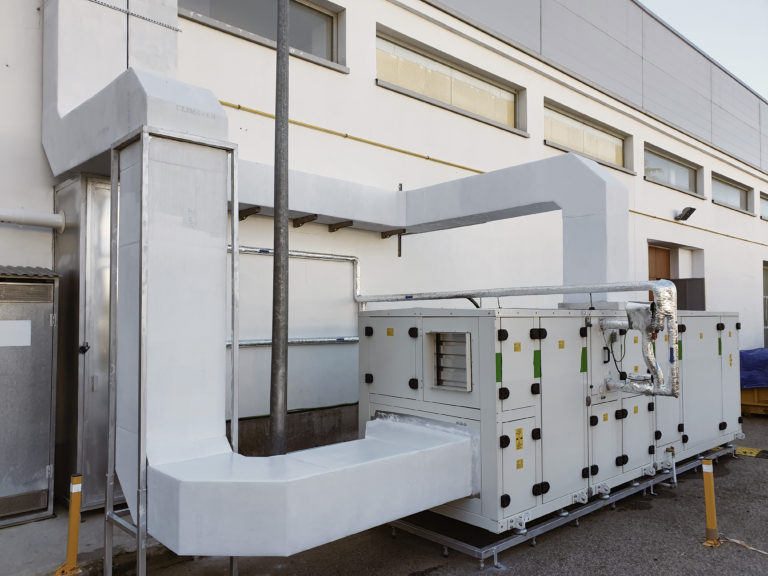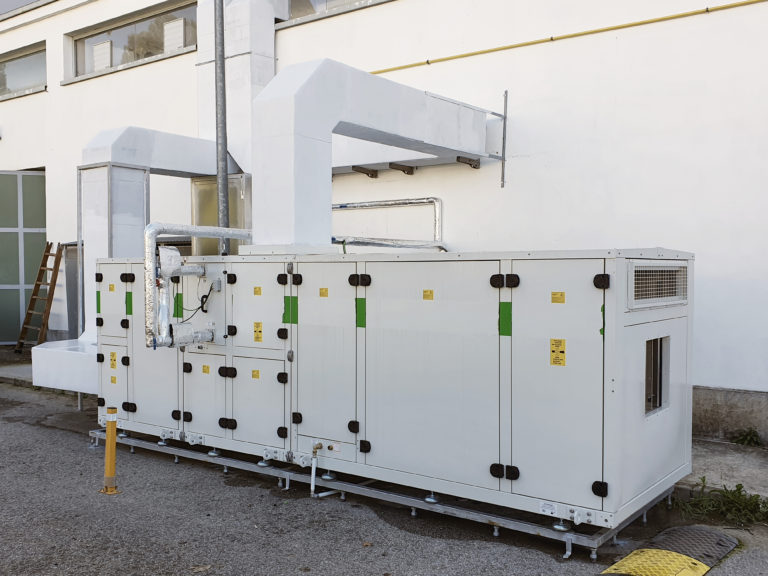The renewable air-cooling unit (RACU) is a desiccant indirect evaporative renewable air-cooling unit for supplying cool air by using low temperature renewable heat source.
The technology is intended for HVAC applications with high Indoor Air Quality requirements, such as hospitals, offices, schools, etc.
Main components and innovation
The main components of RACU are a dew-point indirect evaporative cooler (D-IEC) and a desiccant wheel (DW).
Looking at the system in the direction of the incoming primary air, the system is composed by a DW (which dehumidifies the incoming primary air) and a D-IEC (which cools down the primary air), connected in series one after the other.
The DW is a device, which is typically used for dehumidification of moist air. The device is constructed of a honeycomb structure made of aluminium foil and driven by a motor. The wheel allows two air flow streams to pass through. These streams have separate flow ducts and flow in counter direction. One flow stream is used for regenerating the desiccant wheel, where outside air is first passed through a heating coil, HC, to gain heat and then passed through the desiccant wheel, where it removes the moisture in the wheel mesh. The other air stream takes the humid outside air and passes it through the desiccant wheel, which absorbs the moisture and ultimately provides dry air for the intended purpose.
The main innovation using this setup is that the desiccant wheel is coated with silica gel, which allows the regeneration temperature of the reactivation air to be reduced to 80 °C, enabling the utilisation of heat from renewable energy sources such as solar thermal collectors and 3rd generation district heating.
The combination of DW and IEC makes this device very flexible, as it can control the sensible and latent loads in the buildings for optimal indoor air quality.
Operational modes
The RACU device is able to operate under different climatic conditions and satisfy different needs. The operational modes are:
Ventilation
Air temperature control and ventilation
Humidity control and ventilation
Air temperature control, humidity control and ventilation.
Controllable components
Three independent main control loops are considered in RACU:
- Indoor air temperature control loop,
- Indoor air humidity control loop,
- Ventilation loop.
The control system checks indoor air temperature, indoor air humidity ratio, and concentration of CO2 at each time step, and then it executes the control actions, in order to reach the set-point conditions.
The air humidity control loop modulates the water flow rate of the regeneration heating coil (BC), activates the rotation of the desiccant wheel (DW), and turns on the fan.
The air temperature control loop modulates the water flow rate of the hydraulic pump of the indirect evaporative cooler (IEC).
Finally, the ventilation loop turns on the fans, in case they are turned off, in order to reduce the concentration of CO2 inside the room and improve indoor air quality.
The RACU has two exhaust air streams, one air stream from the desiccant wheel and one air stream from the indirect evaporative cooler. The exhaust air stream from the desiccant wheel exits at approximately 40°C with a high relative humidity. On the other hand, the exhaust air stream from the indirect evaporative cooler is saturated (relative humidity of 100 %) and has a temperature close to the outdoor air temperature.
RACU main characteristics
The RACU main characteristics are:
- RACU employs 100% renewable energy sources, ensuring a very low energy consumption.
- RACU uses 100% outdoor air, ensuring an excellent ventilation and a very high Indoor Air Quality (IAQ) in the building.
- RACU is environmentally friendly since it doesn’t need refrigerants.
- RACU independently controls air temperature and air humidity in the building and thereby
- ensures an excellent thermal comfort for the building occupants.
Researchers from the Research Group in Applied Thermal Engineering of the University of Córdoba have designed and built the RACU prototype, which has been tested at the facilities of the University of Córdoba (Spain).

